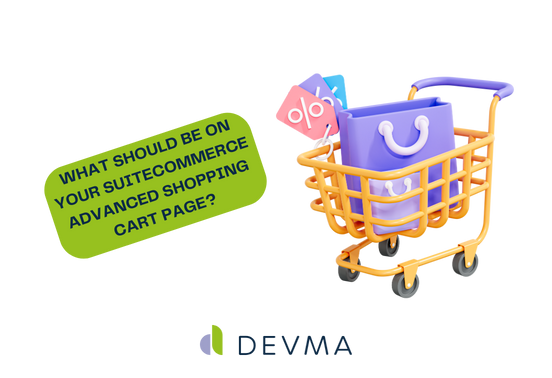Last update: Sep 13, 2024
What Should Be On Your SuiteCommerce Advanced Shopping Cart Page?

Table of contents
E-commerce is the future. Everyone wants to sell products online. However, what sets successful sellers apart from the not-so-successful counterparts is their willingness to ensure a seamless shopping experience for their customers. No matter what you sell, where you sell it, etc., one of the hardest things to get right is the cart page. For sellers using SuiteCommerce Advanced (or SCA), having a cart page that’s UI/UX friendly is critical to converting sales at a higher rate while also retaining customer satisfaction. A checklist can help identify and help alleviate potential problems before they impact your customers. Here’s Devma’s detailed QA checklist for your SCA cart pages!
Page Load Speed
Without a doubt, one of the most important technical aspects of any page on your site is going to be the load speed. A fast-loading cart page on both desktop and mobile will allow you to mitigate high bounce rates, which will also allow you to maintain customer engagement. When trying to fix site speeds, try reducing the size of images and scripts, check any tracking tags that may be slowing the site. There are a ton of free resources to help improve site speeds such as Google’s Site Speed Checker or UberSuggest’s SEO audit – which will give you site speeds for both desktop and mobile.
Mobile Responsiveness
Now that we have site speeds where we want them, we also want mobile-responsiveness to be a top priority. Verify the layout on any device you can; smartphones, tablets, and desktops. Also try to verify the layout on different operating systems such as Android, iOS, Mac, or Windows. Touch interactions should be tested too such as buttons and links. A lot, if not the majority, of online shopping is done on a phone, so make sure you have a mobile-friendly cart.
User Interface (UI) Consistency
Outside of site performance, we also need site appeal. One thing to push site appeal to the max is the user interface you’re working with. This includes the fonts, the colors, button styles, etc. all on the cart page. These should align with the rest of the website to keep the cohesiveness of the brand. If an individual is shopping around, navigation elements such as “proceed to checkout” should be easily accessible, ensuring users can navigate to the checkout page with no confusion.
We would also recommend functionality testing be a part of your UI/UX focus. Why? Well, because it’s a critical aspect and it verifies that items can be added and removed from the cart. Some other functionalities would be allowing quantity updates, removing items, or viewing item changes in real-time. Test discount codes, promotion offers, and see if users can even estimate shipping costs based on their location.
Security and Privacy
Day-by-day, security and privacy are becoming bigger issues. Regardless of if you operate an e-commerce site, a blogging site, or anything else, ensuring privacy and data-security should be top of mind. Ensure the cart page uses HTTPS to secure data transmissions and make sure personal information/data is handled according to your local privacy policies and regulations (obviously GDPR will be different and more intense). Users have to feel safe when entering their personal information and card information for payments.
Analytics and Tracking
Analytics and tracking, on the back end, should not be neglected. Make sure all interactions, such as adding or removing items, applying discounts, and sales are tracked by your analytic tool of choice such as Google Analytics, Meta Pixel, and more. Performance metrics also come into play here. Keep an eye on cart abandonment rate, conversion rate, bounce rate, etc. as they all can provide insights into areas needing improvement.
Integration with Other Systems
NetSuite is a platform built on integrations. So doesn’t it make sense that other systems being easily integrated in your e-commerce site is top of mind? Yes, it is for seamless operation. Verify seamless integration with payment gateways to facilitate smooth transactions and ensure inventory updates are done in real-time. Eventually, these integrations will become your “right-hand partner” in preventing issues like overselling and failed transactions.
Integration with other systems is necessary for a seamless operation. Verify seamless integration with payment gateways to facilitate smooth transactions and ensure real-time inventory updates and synchronization. These integrations prevent issues like overselling and failed transactions.
Takeaways
Performing a QA check on your SuiteCommerce Advanced cart page is essential for maintaining a high-quality shopping experience. In this checklist, we cover key areas to focus on, ensuring that your shopping cart is fast, functional, secure, and overall, user-friendly. By addressing these issues or elements, you’ll eventually reduce most of your car abandonment, improve user satisfaction, and drive more sales so you can add to your bottom line.